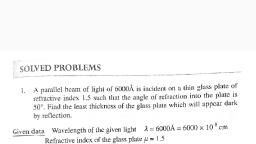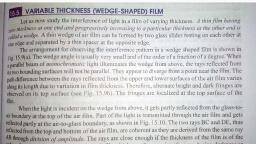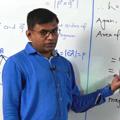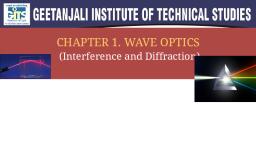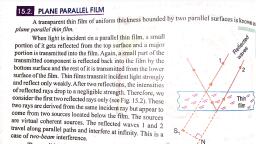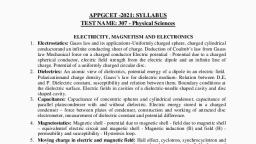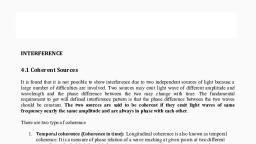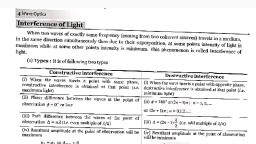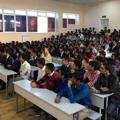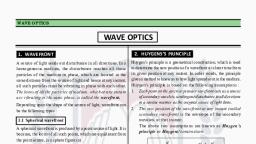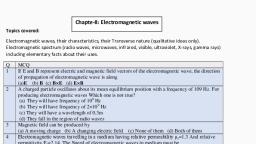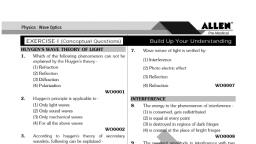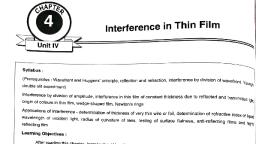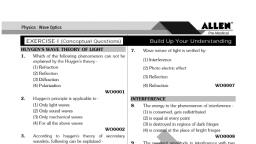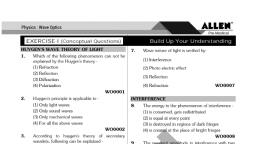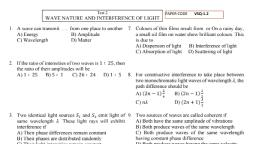Page 1 :
[APTER 1, , PHYSICAL OPTICS—, INTERFERENCE, , I aconenconenec erecta, sant RN RIES, , , , , , , , , , , , , RODUCTION, , Wave theory of light attempts to understand the various optical phenomena, exhibited by light waves. Interference constituted the first proof of the wave, nature of light. Thomas Young first experimentally demonstrated interference, in light waves. The superposition principle forms the conceptual basis for the, , explanation of interference. To produce interference, the light waves should be, , coherent, i.e., the light waves should have constant phase difference and same, , frequencies., , 1.1 INTERFERENCE, , re light waves superimpose in the medium then according to, e resultant displacement at any point is equal to the, , algebraic sum of the displacements due to individual waves. If y, and y, are the, displacements due to two light waves | and 2, then the resultant displacement of, the resultant wave is given by y=) + Y2- The variation of resultant displacement, influences amplitude variation, which causes intensity variations. This modifi, cation in the distribution of intensity in the region of superposition is known as, interference. When the resultant amplitude is the sum of the amplitudes due to, , Resultant, light wave, , When two or mo:, superposition principle, th, , Light wave 4, , , , , , , , , , , <|_ Resultant, light wave, , Light wave 2 Light wave 2, , (b), , e interference vy’ =i + y)5, , (a), Figure | Zl, , (a) Constructiv, (b) Destructive interference (y =, ~J’2)
Page 2 :
1.2 Engineering Physics, , @, two light waves, the interference is constructive interference (Fig. 1.1(a)). If the, resultant amplitude is equal to the difference of two amplitudes, the interference, becomes destructive interference (Fig. |.1(b)). The intensity variations are, studied as interference patterns or fringes or bright and dark fringes., , 1.1.1 Coherence, , To observe interference, the two light waves should be coherent. The two light, wayes are said to be coherent if they have the same frequency (wavelength) and, they are in phase or maintain a constant phase relationship, When such light waves, superimpose, they give, rise to an interference pattern. The light waves emitted, by two independent light sources do not have a constant phase relationship for a, long time and they have randomly varying phase relationship. Due to which, they, do not produce stationary interference pattern., , When a light from a single source is made to split into two wavefronts by, using two slits, then these split wavefronts act as if they emerged from two, sources having a fixed phase relationship and by superimposition, they produce a, stationary interference pattern. The process of maintaning constant phase relation, is known as coherence., , Coherence is of two types., 1. Temporal Coherence _ If it is possible to predict the phase relation at, , a point on the wave w.r.t. another point on the same wave then the wave, has temporal coherence., , Ww, , - Spatial Coherence If it is possible to predict the phase relation at a, , point on a waye w.r.t. another point on a second wave, then the wave is, said to have spatial coherence., , 1.1.2 Conditions for Interference, , 1. The two light sources emitting light waves should be coherent,, , 2. The two sources must emit continuous light waves of same wavelengths, and frequency., The separation between the two sources should be small., , The distance between the two sources and the screen should be large., . To view interference fringes, the background should be dark, ‘, 6, The amplitudes of the light waves should be equal or nearly equal., , 7. The sources should be narrow, i.e., they must be small., , 8. The sources should be monochromatic., , ww, , 1.1.3. Interference in Thin Film by Reflection, , When light is incident on a plane parallel thin film, some portion gets reflected, from the upper surface and the temaining portion is transmitted into the film., Again, some portion of the transmitted light is reflected back into the film by, the lower surface and emerges through the upper surface. These reflected light
Page 4 :
Engineering Physics ., 14 @ J ~, , From Snell’s law, sini = /t sine, BG = 2uttanr sinr (4), , Substituting the above values in Eq. (1), , , , iff oe 2ut tan r sin r, Path difference = Z55>;— 2d tan, , = 2), 2Qut = 2ut sin-r, ~tosr cosr, , , , , , b, F 2ult 2 Bi Ey, p = Goer (1 - sin") = ggg C087, = 2utcosr (5), , At the point B, reflection occurs from the upper surface of the thin film, , (denser medium). Light ray (1) undergoes an additional phase change of z or an, additional path difference of, , Total path difference = 2ur cos r 2, , When the path difference is equal to integral multiples of A then the rays (1), and (2) meet in phase and undergo constructive interference,, The condition for bright fringe is, 2ut cos r+ a =nad, , 2ut cos r= (2n — p4 where n = 0, 1, 2, 3... (0), , When the path difference is equal to half integral multiples of A then the rays, (1) and (2) meet in out of phase and undergo destructive interference., The condition for dark fringe is, , ut cos r+ 2 = (On 4, , 2ultcosr=nd where n =0, 1,2,3... (7), , Depending on the above conditions, the interference pattern consists of bright, and dark fringes, ‘, , 1.2 NEWTON’S RINGS, , Newton's rings are one of the best examples for the interference in a nonuniform, thin film. When a plano-convex lens with its convex surface is placed on a plane, glass plate, an air film of increasing thickness js formed between the two. The, thickness of the film at the point of contact is zero. If monochromatic light |!, allowed to fall normally and the film is viewed in the reflected light, alternate
Page 5 :
o_ Physical Optics—Interference 1.5, , rk and bright ring ;, a - 8S concentric around the point of contact between the lens, , and glass plate are seen. These circ ;, : ular rin i, called Newton’s rings. gs were discovered by Newton and are, , 1.2.1 Experimental Arrangement, , The experimental arrangement is as shown in Fi, : nin Fig. 1.3. =, a are radius of aiecume ig. 1.3. The plano-convex lens (L), , is placed with its convex cea Microscope, surface on a plane glass *, , , , , , , , , , plate (P). The lens makes, , the contact with the plate rag:, , at ‘O’. The monochromatic ., light falls on a glass plate G ais (| oe, held at an angle of 45° with o, , the vertical. The glass plate, , G reflects normally a part of, , the incident light towards the —" aa (J-> Plano-Convex Lens (L), , air film enclosed by the lens a Plane Glass Plate (P), Land the glass plate P. A part Oo, , of the light is reflected by the, curved surface of the lens L, and a part is transmitted which is reflected back from the plane surface of the, plate. These reflected rays interfere and give rise to an interference pattern in the, form of circular rings. These rings are scen near the upper surface of the air film, , through the microscope., , Figure 1.3 Newton's rings (Experimental set up), , 1.2.2. Explanation of Newton’s Rings, , Newton’s rings are formed due (0, interference between the light rays, reflected from the top and bottom, surfaces of air film between the, plate and the lens. The formation \, of Newton’s rings can be explained Se, By Air Film, with the help of Fig. 14.4 part Se, of the incident monochromatic O c, fence 8H) gc emt, a, wit additi nase (or path) ae Pande wenlaes, with any ational PPP ah is erected lene BC ae, boundary), it is again reflected in the form of the ray (2) wi al phas, , , , , , », , change of z or path change of 5

